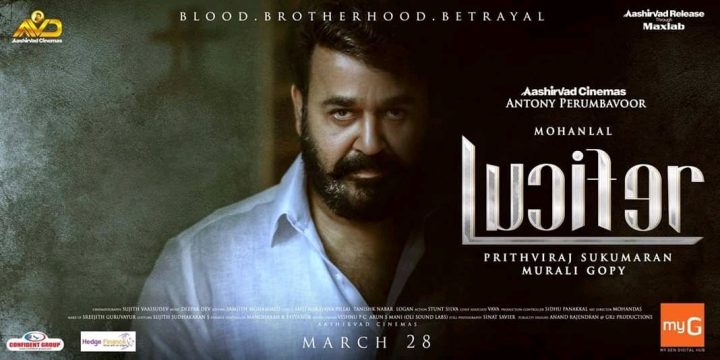The hero-centric masala movie stands as the backbone of South Indian cinema, elevating stars like Rajni, Vijay, Ajith, and Surya to unparalleled heights. However, a noticeable trend has emerged, where films within this genre seem to blend into a homogeneous landscape, lacking diversity and depth. The scripts, unfortunately, are thinning out even as budgets inflate, creating a formulaic sameness in storytelling.
Refreshing Departures: “Petta” and “Lucifer”
In this scenario, “Petta” brought a breath of fresh air to the masala genre, presenting Thalaiva in a new light, thanks to the creative vision of director Karthik Subbaraj. A similar paradigm shift is evident in “Lucifer,” where debut director Prithviraj Sukumaran, a star himself, crafts a cinematic world around Malayalam cinema’s biggest superstar, Mohanlal. This film is not just a fan’s tribute but a testament to a director’s astute cinematic prowess.
Crafting a Unique Narrative
Murali Gopy, the mind behind the script, acknowledges the familiar arc inherent in such stories but masterfully weaves together elements of political drama, emotional conflicts, and narrative tropes to transcend the commonplace. “Lucifer” becomes an exquisite blend of homage to a matinee idol and a director’s commitment to offering a distinctive cinematic experience. The film breaks free from the shackles of predictability, infusing new life into a well-trodden genre.

‘Petta’ and ‘Lucifer’ emerge as refreshing departures within the masala genre, with directors like Karthik Subbaraj and Prithviraj Sukumaran injecting new life into familiar tropes, creating a cinematic experience that transcends the commonplace.
If you look closely Lucifer has all the standard elements of a mass hero tropes. The treatment of the scenes is what makes it an interesting watch.
- The Stage is set: in a typical mass hero film there is small prologue before we see the entry. This is usually the ‘avar varuvar’ dialogue by the sidekick or an oppressed common man. In Lucifer before Stephen enters the screen, we get a set up but the way it is written is what makes it interesting. Indrajith Sukuraman as the conspiracy theorist (he even mentions the most popular of the theories, Illuminati in a later scene) is used as the narrative device to create a mist of myth around Stephen, about him culminating with his christening to Lucifer.
- Enter Lucifer, Good Devil: You hear Stephen before you see him. From the setup the audience already imagine him to be this power centre and then Mohanlal’s stoic delivery already make him larger than life. When you first see Stephen, he is inside a church (first of the fallen imagery), the camera zooms to his face and the intensity in his eyes convince you that he is Lucifer. When Stephen alights from his vehicle (that is aptly numbered) and walks among the crowd, you see his stature among people. No flying goons, intro songs with paeans alluding to the character and the star playing it and ‘punch’ dialogues are necessary. The director has established man at the centre of this movie’s universe.
In the realm of masala movies, stars like Rajni, Vijay, Ajith, and Surya have dominated, but lately, scripts have grown thinner as budgets expand, leading to a concerning sameness in storytelling.
- Show of Strength: The rite of passage of every star vehicle. Stephen does get to beat up the goons but the heavy lifting in this action scene is done by Mohanlal’s face. The expressions, the fierce gaze make it believable. It does not seem unreal even though the actor does not have the body or agility to pull of the action sequences. In many other ageing star’s hands this scene would look unintentionally funny, but not with Mohanlal. It also shows the power of an Actor-Star and the edge he has over others who fall in only of the buckets.
- The Interval Twist: The fall (?) of Stephen provides the necessary interval twist. But the intermittent time before his rise is peppered with an interesting sequence involving an ex-revolutionary that leads to talk of unworthy children, amicable political rivalries, and a beautiful comrade song.Stephen waits calmly in prison for the opportune moment and Mohanlal’s expressions do not betray any emotion at this stage. You realize there must be a well laid-out plan that will take care of things.
Unveiling Stephen’s Past

- ‘Avan yaaru teriyuma’ flashback: Stephen’s past unfolds organically throughout the film, allowing viewers to connect the dots with their own imagination. Unlike the typical hero flashback sequences, the movie avoids the cliché approach pioneered by ‘Baasha,’ presenting a clever screenplay that effectively reveals Stephen’s history without relying on overused tropes.
- Fight to Death: The climax fight is unique in the way that Stephen does not raise a finger all through the fight. Yet he strides majestically like a king through the battlefield with enemy soldiers falling around him and clearing his path. The devil then quotes the scripture (Mohanlal rendering Ezekiel 25:17 in his own style, diametrically opposite to Samuel Jackson’s rendition in the classic Pulp Fiction) and closes the chain of events.
- Coronation of the Devil: Stephen, Lucifer, Khureshi Abram (Unholy Trinity?) – one man, 3 names. You see the actual man only in the epilogue and only for a moment. Leaving you wanting for more, for the pre-planned sequels.
Lucifer was a welcome break from the one-size-fits-all template of the ‘hero’ movie. The bar was raised slightly higher for the subsequent movies in the similar genre. Would be interesting to watch other superstars from the different industries take this to the next level. The routine punch dialogues, flying vehicles and dances with much younger actresses are becoming a drag.

Captive of the 24 frames and admirer of the written word. If it is not on the silver screen or on the pages of a paperback, it might as well not exist.

